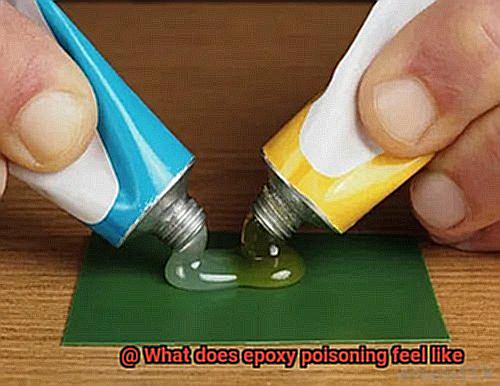Epoxy resins are like a double-edged sword – they’re incredibly useful, but also come with some serious health hazards. If you’re not careful while working with these materials, you could end up with epoxy poisoning. This condition occurs when toxic substances found in epoxy resins get ingested or inhaled, leading to a variety of symptoms and illnesses.
The effects of epoxy poisoning can vary widely depending on the severity of exposure and individual sensitivity to chemicals. Some folks may only experience mild symptoms like skin irritation or nausea, while others may suffer from more severe reactions such as respiratory problems, seizures, or even coma. And here’s the kicker: symptoms may not show up immediately after exposure – sometimes taking days or even weeks to develop.
In this blog post, we’ll explore the signs and symptoms of epoxy poisoning so that you can be informed and stay safe. Whether you work in an industry that involves handling these materials or just want to be aware of the risks associated with them, we’ve got you covered. So let’s dive in and learn how to protect ourselves from the dangers of epoxy poisoning.
What is Epoxy Poisoning?
Contents
Epoxy resin is a popular adhesive that is widely used in industrial, construction, and DIY projects. However, it can also be dangerous if not handled with care. Epoxy poisoning occurs when excessive amounts of epoxy resin or hardener are inhaled or come into contact with the skin or mouth.
When epoxy resin and hardener are mixed, they produce heat and release fumes that can irritate the nose, throat, and lungs. The severity of the symptoms depends on the amount and duration of exposure. Inhaling epoxy fumes can cause coughing, wheezing, shortness of breath, headaches, dizziness, nausea and vomiting. Prolonged exposure to these fumes can have serious long-term health effects such as liver and kidney damage, nervous system damage, and cancer.
Ingesting epoxy resin or hardener can cause chemical burns in the mouth and throat leading to difficulty swallowing and breathing. Skin contact with epoxy resin can cause irritation, redness, itching, chemical burns, and allergic reactions. Protective clothing such as gloves, goggles, and a respirator mask should be used when working with epoxy resin to avoid any skin contact.
It is essential to work in a well-ventilated area or use a fume hood when working with epoxy resin to reduce exposure to harmful fumes. If you experience any symptoms of epoxy poisoning such as headaches, dizziness, nausea or vomiting seek medical attention immediately. Treatment may include removing the person from the source of exposure, providing oxygen therapy if necessary, and administering medication to reduce inflammation.
Symptoms of Epoxy Poisoning
It’s important to remember that epoxy can be a hazardous substance if not handled with care. Exposure to epoxy can lead to a range of symptoms, depending on the severity of exposure.
Short-term symptoms of epoxy poisoning include respiratory irritation, which can manifest as coughing, wheezing, and shortness of breath. These symptoms can be alarming and uncomfortable for anyone who has worked with epoxy in a poorly ventilated area. On the other hand, skin irritation or chemical burns are also potential symptoms if uncured epoxy comes into contact with your skin.
Ingesting epoxy is another way that one can be exposed to its harmful effects. Consumption can lead to nausea, vomiting, and abdominal pain. It’s crucial to keep epoxy products out of reach of children and pets to avoid accidental ingestion.
Prolonged exposure to epoxy fumes is where more severe health problems arise. Workers who frequently handle epoxy products are at risk of developing chronic respiratory problems such as asthma or bronchitis. Skin sensitization and dermatitis are also common in individuals who are regularly exposed to uncured epoxy.
If you suspect that you’ve been exposed to epoxy fumes or come into contact with uncured epoxy, seek medical attention immediately. Severe cases of poisoning can lead to seizures, loss of consciousness, and even death.
To minimize the risk of exposure, take precautions when working with epoxy products. This includes working in a well-ventilated area and wearing protective clothing and gloves. Avoid skin contact with uncured epoxy at all costs. If you experience any symptoms while working with epoxy resin, stop working immediately and seek medical attention.
Inhaling Fumes of Epoxy
If you’re working with epoxy, it’s crucial to understand the potential health risks associated with inhaling its fumes. Don’t be fooled by its harmless appearance – inhaling these fumes can lead to severe respiratory problems, skin irritation, and even chronic health issues like asthma or bronchitis. So let’s dive deeper into the dangers of inhaling epoxy fumes.

The primary risk of inhaling epoxy fumes is that it can cause respiratory problems, especially if the fumes are concentrated or inhaled for an extended period. Epoxy fumes can cause lung irritation, leading to shortness of breath, wheezing, and coughing. In severe cases, it can even cause fluid buildup in the lungs, which is life-threatening if not treated promptly.
But that’s not all. Inhaling epoxy fumes can also cause headaches, dizziness, and nausea. This is because of the high levels of volatile organic compounds (VOCs) released from the epoxy during the curing process. And if you come into contact with the epoxy resin, it may also cause skin irritation or allergic reactions.
To prevent exposure to these harmful fumes, ensure you use protective equipment such as respirators or ventilators when working with epoxy. Proper ventilation in your workspace is also crucial for your safety. It’s important to note that the severity of these symptoms varies based on the concentration of the epoxy fumes and the duration of exposure.
If you experience any of these symptoms after coming into contact with epoxy fumes, don’t hesitate to seek medical attention immediately. Prompt treatment can be lifesaving in some cases.
Skin Contact with Epoxy
Epoxy resin is a versatile adhesive that is commonly used for bonding, coating, and sealing surfaces. However, it is crucial to note that it contains harmful chemicals that can cause serious health problems.
Skin contact with epoxy can lead to a range of symptoms such as redness, itching, burning sensation, and swelling. These symptoms can vary depending on the level of exposure and sensitivity of the individual. Prolonged exposure to epoxy resin can also cause allergic reactions that manifest as rashes or hives on the skin.
It is essential to take immediate action if you experience any symptoms of skin contact with epoxy. The first step is to remove any contaminated clothing and wash the affected area thoroughly with soap and water. If the symptoms persist or worsen, seek medical attention immediately.
To prevent skin contact with epoxy, it is recommended to wear protective clothing such as gloves and long-sleeved shirts when handling the adhesive. It’s also important to work in a well-ventilated area to minimize inhalation of harmful fumes. Here are some other tips to keep in mind:
- Always read the safety instructions and warnings on the product label before use.
- Avoid skin contact with epoxy by wearing protective clothing and gloves.
- Use epoxy in a well-ventilated area to minimize inhalation of fumes.
- Wash your hands thoroughly after handling epoxy.
Remember that prevention is better than cure when it comes to skin contact with epoxy. Taking necessary precautions will help you avoid any adverse health effects.
Treatment for Epoxy Poisoning
Working with epoxy resin and hardener can be dangerous if proper precautions are not taken. If you suspect that you have been exposed to epoxy and are experiencing symptoms, seek medical attention immediately. Symptoms of epoxy poisoning can range from mild irritation to severe respiratory distress and neurological damage. Ingesting or inhaling epoxy can cause nausea, vomiting, headache, dizziness, and confusion.
Treatment for epoxy poisoning will depend on the severity of the symptoms. In mild cases, the affected person may be given oxygen to help them breathe and fluids to prevent dehydration. However, in more severe cases, hospitalization may be necessary. Additionally, the person may require oxygen therapy, intravenous fluids, and medications to control their symptoms. In extreme cases, mechanical ventilation or even surgery may be required to remove the affected tissue.
Prevention is the key to avoiding epoxy poisoning. Anyone who works with epoxy should wear protective gear like gloves, clothing, and eyewear. Working in a well-ventilated area can also help reduce the risk of inhaling or ingesting any of the product.
Prevention of Epoxy Poisoning
Epoxy is a fantastic adhesive, perfect for countless DIY projects, repairs, and crafts. However, it can also be hazardous if not handled correctly. Epoxy poisoning can lead to severe respiratory distress and neurological damage, which makes it essential to know how to avoid it. In this article, we’ll explore some crucial tips to keep you safe from epoxy poisoning.
Firstly, always use epoxy in a well-ventilated area. It’s vital to work outdoors or in a room with windows and doors open for proper air circulation. Epoxy fumes are harmful if inhaled in large quantities. Therefore, it’s crucial to ensure that the air around you is fresh and clean and the fumes are not concentrated.
Secondly, protective gear is mandatory when working with epoxy. Wearing gloves, goggles, and a respirator mask can protect your skin and eyes from contact with the epoxy and prevent inhaling the fumes. A single exposure to epoxy can cause skin irritation or worse if proper precautions are not taken.
Thirdly, keep epoxy away from children and pets. Children and pets are curious creatures that may ingest epoxy accidentally. Epoxy is toxic if ingested by children or pets. Therefore, store it in a safe place out of their reach. A locked cabinet or shelf is an excellent option.
Fourthly, follow instructions carefully. It’s crucial to read and adhere to the instructions on the epoxy packaging carefully. Do not exceed the recommended mixing ratios or curing times as it can lead to adverse effects. The instructions also provide valuable information on how to handle the epoxy safely.
Lastly, dispose of leftover epoxy properly. Do not dispose of leftover epoxy in the trash or down the drain as it can contaminate the environment. Check your local regulations for proper disposal methods and follow them strictly.
RHd0DEVrq1s” >
Conclusion
As we wrap up our discussion on epoxy poisoning, it’s important to remember that this versatile adhesive comes with significant health risks. From mild skin irritation to severe respiratory distress and neurological damage, the symptoms of epoxy poisoning can be alarming.
To prevent exposure to harmful fumes, always work in a well-ventilated area or use a fume hood. And don’t forget to suit up in protective gear like gloves, goggles, and a respirator mask. These precautions may seem like common sense, but they’re essential for your safety when working with epoxy resin and hardener.
If you do experience any symptoms of epoxy poisoning – such as headaches, dizziness, nausea or vomiting – seek medical attention immediately. Treatment may include removing the person from the source of exposure, providing oxygen therapy if necessary, and administering medication to reduce inflammation.
Remember: prevention is key when it comes to avoiding epoxy poisoning. Always follow instructions carefully and keep leftover epoxy out of reach of children and pets. Proper disposal is also crucial for protecting yourself and the environment.
By taking these necessary precautions, you can avoid any adverse health effects associated with epoxy resin and hardener.






